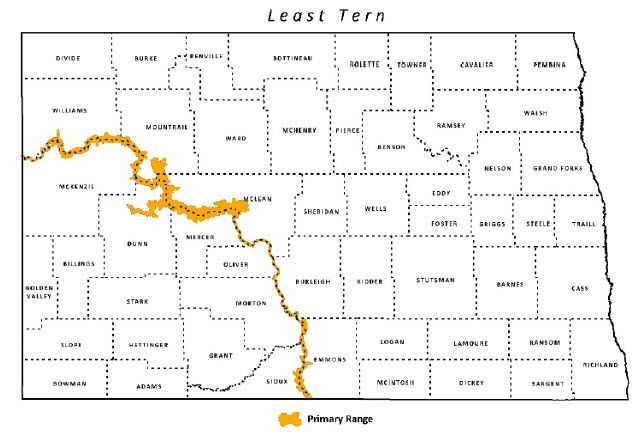
Least Tern
| Scientific Name | Sterna antillarum athalassos |
|---|---|
| General Description | L 9”, WS 20”, 1.5 oz. The smallest of terns, it has a bright yellow bill with a black tip, yellow legs and white forehead. |
| Status | Occurs in North Dakota from mid-May to mid-August. Peak breeding season occurs from mid-June to mid-July. |
| Abundance | Rare. |
| Primary Habitat | Sparsely vegetated sandbars or shorelines. |
| Federal Status | Migratory Bird (Delisted ESA Jan, 2021) |
| Reason for Designation | Listed as endangered in 1985. The alteration of the natural Missouri River stream flow from dam construction and river channelization has destroyed or degraded sandbar habitat and altered tern prey. |
Locations and Conditions of Key Habitat
Preferred Habitat
Least Terns use sparsely vegetated sandbars or shoreline salt flats of lakes along the Missouri River System in North Dakota. Usually nest in small colonies (less than 20 nests) with nests spaced far apart. The nest is a hollow scrape, sometimes located among stones. The size of nesting areas is highly dependent on water levels. Forage primarily for small (2-9 cm), non-spiny fish but also shrimp and other invertebrates. Foraging takes place close to the nesting colony.
Key Areas and Conditions for Least Tern in North Dakota
The Yellowstone River, Missouri River, Lake Sakakawea, and Lake Oahe are the only areas in the state where Least Terns reside.
Problems Which May Affect this Species
Habitat
As a result of channelization, irrigation, and dam construction along the Missouri River, the sandbar habitat has been drastically altered, and cold, deep water has changed the forage fish. Encroachment of woody vegetation onto sandbars reduces nesting habitat availability.
Other Natural or Manmade Factors
Nests may be destroyed by recreationists using sandbars or by the release of water during mid-summer when terns are still on the nest. The effect of bio-accumulation of contaminants in fish prey base is unknown.
Research and Survey Efforts
Current Research or Surveys
- The U.S. Army Corps of Engineers annually surveys Least Terns along the Missouri River system. The program was initiated in 1993. The number of nests, nest success, destroyed nest fate, the number of chicks fledged, and the fledge ratio are calculated.
- Northern Prairie Wildlife Research Center is conducting comprehensive surveys and research on various aspects of Least Tern and piping plover habitat, demographics, population dynamics, foraging ecology, and monitoring in the entire Missouri River system.
- The University of North Dakota is using miniature surveillance cameras at Least Tern and piping plover nests to provide information about predators and behavior.
Previous Research or Surveys
- Numerous published reports and gray literature for the species throughout its range.
Additional Research or Surveys Needed
Nothing at this time specific to North Dakota.
Population and Trend Estimates
- North American Waterbird Conservation Plan Population Estimate: 60,000-100,000 total breeders with 8,000 in the interior population
- NPPWCP BCR11 Population Estimate: ~680
- North Dakota Population Estimate: ~100 breeding pairs
Management Recommendations
- Mimic natural flows on the Missouri River to create sandbar habitat.
- The creation of dredged islands or clearing of sandbar vegetation may provide new nesting habitat for terns, but the productivity is presumed to be much less than for natural sites.
- Manage sandbar habitat by removing features that terns avoid (e.g. vegetation, silt).
- If needed, limit human access to sandbars or sensitive areas where terns are nesting.
- The 1990 Recovery Plan may no longer reflect the best available information, use more recent published reports and the 5-year Review for management goals.
Monitoring Plans
Continue to work with the U.S. Army Corps of Engineers and the U.S. Fish and Wildlife Service on long-term monitoring of Least Terns along the Missouri River System. Northern Prairie Wildlife Research Center staff have identified a proposed revision of the monitoring program (see Shaffer et al. 2013). If delisted, a post-delisting monitoring strategy and plan must be developed.
2005-2015 Progress
The Least Tern remains a Level II Species of Conservation Priority. The 5-year review concludes the Interior population of Least Terns is recovered and recommends the species be considered for delisting.

Note: A listing of works consulted when compiling the information on this page may be found in the 2015 State Wildlife Action Plan.
